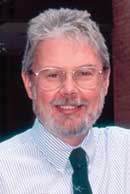From the Director
by Lee Allison,
Director and State Geologist

Do we really need to worry about geologic hazards?
The three families in Johnson County whose homes collapsed in landslides
in 1995 would likely say we do.
Kansas
needs an ongoing geologic hazards identification and mitigation program.
We owe it to the people whose homes and lives may be affected by landslides,
expansive soils, and, yes, even earthquakes.
When we talk about earthquakes and landslides, we generally don’t
think of Kansas. We usually associate those natural disasters with California
and the mountainous states. Natural disasters in Kansas are dominated
by tornadoes and floods. Do we really need to worry about geologic hazards?
The three families in Johnson County whose homes collapsed in landslides
in 1995 would likely say we do.
Although landslides are not a pervasive problem in Kansas, they are potentially
serious, particularly in the eastern part of the state, with its steep
bluffs and hills. Recent mapping by Survey geologist Greg Ohlmacher in
the Atchison area is the start of a detailed statewide assessment of landslide
hazards. State geological surveys also are working with the U.S. Geological
Survey to develop a national cooperative landslide hazard reduction program,
modeled in part on the extremely successful National Cooperative Geological
Mapping Program. In this proposed program, landslide is used as a catch-all
term for any kind of related hazard, including debris flows, sinkholes,
collapsible soils, and subsidence.
That definition also includes expansive soils, a more pervasive problem
in Kansas. These are common in areas underlain by clay deposits. Water
can easily be trapped between clay layers, causing the clays and derivative
soils to expand. During dry periods, the water evaporates and the clays
and soils shrink. The result is soils that heave and shrink from season
to season, cracking foundations, driveways, and sidewalks. Most everyone
knows someone who has had foundation problems caused by problem soils.
No one has estimated the damages and losses to expansive soils in the
state. Detailed maps are needed to help develop avoidance and mitigation
strategies.
The earthquake hazard in Kansas also is not well understood. Only a handful
of felt earthquakes have occurred in modern Kansas history, the largest
in the Manhattan region. Many of the large earthquakes have been associated
with the Humboldt fault zone, a distributed system that runs from Oklahoma,
across Kansas, into Nebraska. Survey research, plus the results of a 12-year
seismic monitoring program in the 1970’s and 1980’s, indicates
that the Tuttle Creek Dam in Riley County is susceptible to seismic shaking.
The Survey presented this conclusion recently to a joint legislative committee.
The U.S. Army Corps of Engineers, which operates Tuttle Creek Reservoir,
has completed extensive seismic-hazard analysis of the dam and determined
that an earthquake of magnitude 5.7 or larger under the dam could cause
it to fail. A decision needs to be made whether to upgrade the dam’s
ability to withstand seismic events, leave the dam as it is and risk the
possibility of failure, or remove the dam altogether. Retrofitting the
dam is expensive, but the consequences of a dam failure would be catastrophic.
The Survey’s mission is to investigate and report on the geology, resources, and hazards of the state. Our programs in resources—oil, natural gas, and ground water—are large, highly visible, and influential. The results of these programs lead to economic development. We need to put similar resources to work in saving lives and property.
![]()
Online February 10, 2003
Comments to: lbrosius@kgs.ku.edu
Kansas Geological Survey
URL:http://www.kgs.ku.edu/Publications/GeoRecord/2001/vol7.3/Page2.html